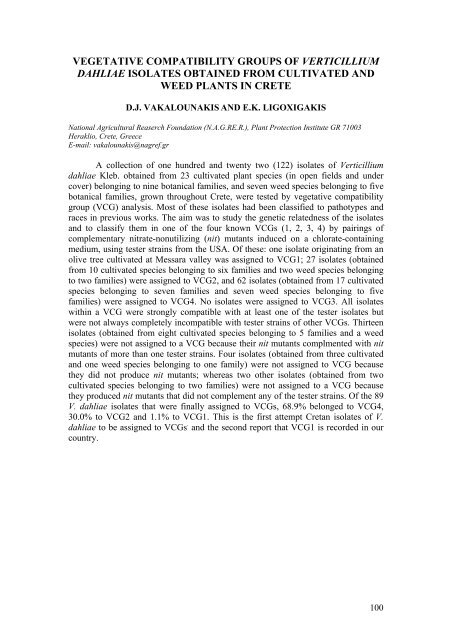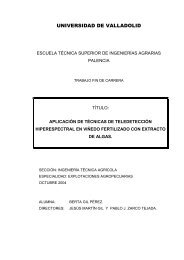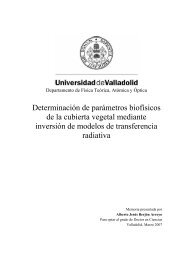VEGETATIVE COMPATIBILITY GROUPS OF <strong>VERTICILLIUM</strong>DAHLIAE ISOLATES OBTAINED FROM CULTIVATED ANDWEED PLANTS IN CRETED.J. VAKALOUNAKIS AND E.K. LIGOXIGAKISNational Agricultural Reaserch Foundation (N.A.G.RE.R.), Plant Protection Institute GR 71003Heraklio, Crete, GreeceE-mail: vakalounakis@nagref.grA collection of one hundred and twenty two (122) isolates of Verticilliumdahliae Kleb. obtained from 23 cultivated plant species (in open fields and undercover) belonging to nine botanical families, and seven weed species belonging to fivebotanical families, grown throughout Crete, were tested by vegetative compatibilitygroup (VCG) analysis. Most of these isolates had been classified to pathotypes andraces in previous works. The aim was to study the genetic relatedness of the isolatesand to classify them in one of the four known VCGs (1, 2, 3, 4) by pairings ofcomplementary nitrate-nonutilizing (nit) mutants induced on a chlorate-containingmedium, using tester strains from the USA. Of these: one isolate originating from anolive tree cultivated at Messara valley was assigned to VCG1; 27 isolates (obtainedfrom 10 cultivated species belonging to six families and two weed species belongingto two families) were assigned to VCG2, and 62 isolates (obtained from 17 cultivatedspecies belonging to seven families and seven weed species belonging to fivefamilies) were assigned to VCG4. No isolates were assigned to VCG3. All isolateswithin a VCG were strongly compatible with at least one of the tester isolates butwere not always completely incompatible with tester strains of other VCGs. Thirteenisolates (obtained from eight cultivated species belonging to 5 families and a weedspecies) were not assigned to a VCG because their nit mutants complmented with nitmutants of more than one tester strains. Four isolates (obtained from three cultivatedand one weed species belonging to one family) were not assigned to VCG becausethey did not produce nit mutants; whereas two other isolates (obtained from twocultivated species belonging to two families) were not assigned to a VCG becausethey produced nit mutants that did not complement any of the tester strains. Of the 89V. dahliae isolates that were finally assigned to VCGs, 68.9% belonged to VCG4,30.0% to VCG2 and 1.1% to VCG1. This is the first attempt Cretan isolates of V.dahliae to be assigned to VCGs . and the second report that VCG1 is recorded in ourcountry.100
DETERMINATION OF PATHOTYPES OF <strong>VERTICILLIUM</strong>DAHLIAE AND NEW HOSTS OF V. DAHLIAE RACE-2, ANDSPREAD OF THE PATHOGEN IN CRETEE.K. LIGOXIGAKISNational Agricultural Reaserch Foundation (N.A.G.RE.R.), Plant Protection Institure GR 71003 Crete,GreeceE-mail: nagrefhe@otenet.grVerticillium dahliae Kleb. is a soil-borne fungus infecting more than 400cultivated and weed plant species, worldwide, causing usually severe disease andsubstantial damage. Two physiological races (1 and 2) and several pathotypes of thepathogen have been identified. A collection of 105 V. dahliae isolates obtained from37 plant species (25 cultivated and 12 weed) belonging to 13 botanical families andgrown on several areas of Crete was used in the present study, with the purpose toidentify pathotypes and races.Crassification of isolates to pathotypes was attempted by examining theirpathogenicity, using the root-dipping technique on four differential plant species(eggplant, pepper, tomato and turnip). Of the 105 V. dahliae isolates: 71 obtainedfrom 31 infected species (22 cultivated and 9 weed) belonging to 10 botanic families,were determined to the pathotype I (proved pathogenic to tomato, eggplant, andturnip), 26 obtained from <strong>16</strong> species (10 cultivated and 6 weed) belonging to 7botanical families were classified to the pathotype II (proved pathogenic to eggplantand turnip), whereas the remaining 8, obtained from 2 cultivated species belonging toone botanical family were classified to the pathotype III (proved pathogenic to all fourdifferential species). The conclusions are: a) the pathotypes I, II, and III of V. dahliaewere greatly, moderately, and lightly spread, respectively, in Crete, and b) thepathotype IV (isolates pathogenic only to turnip, according to Japanese workers),lacks in Crete.Crassification of isolates to races was attempted by examining theirpathogenicity, using two differential tomato varieties: Earlypack No 7 (lacking the Veresistance gene) and ACE 55 VF (possessing the Ve gene), using the root-dippingtechnique. Of these 105 V. dahliae isolates, 50 obtained from 21 cultivated species:bean * , broccoli * , cabbage * , cauliflower * , chickpea, chicory * , cucumber * , eggplant,endive * , melon, ochrus pea * , olive tree, pepper * , potato * , Romaine lettuce, radish * ,summer squash, masigold * , tomato, vetch * , and watermelon, as well as 17 isolatesobtained from 9 weed species: black nightshade, common groundsel * , Erodium sp. * ,field bindweed * , hoary cress * , shepherd’s purse * , senape * , Trifolium sp. * , and wildradish * proved to belong to race-2. Of the remaining 38 isolates, 12 obtaining from 10species (9 cultivated and one weed) proved to belong to race-1, whereas 26 obtainedfrom <strong>16</strong> species (10 cultivated and 6 weed) proved non-pathogenic to tomato. Theconclusions are the identification of: a) <strong>20</strong> worldwide new hosts of race-2 (thesewhich are listed with asterisks) and b) 10 known hosts of it (these which are listedwithout asterisks). Race 2 of the fungus proved widely spread in Crete infecting Vetomatoes, vegetables, olive trees, etc (such as in the Lasithi plateau and the Messaravalley areas). A 84.8% of the pathogenic to tomato isolates used belong to race-2,whereas the remaining 15.2% belong to race-1. Today because of its spread, race-2 isa serious problem to many vegetables in Crete.101




